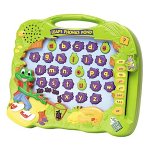LeapFrog Phonics Pond
Learning games that challenge children to find letters, hear their phonetic sounds, and create more than 450 words
 Six exciting learning games challenge children to find letters, hear their phonetic sounds and create more than 450 words, jumping fish light up to reward correct answers. Music adds to the fun - press a letter to hear a catch tune! Teaches letters, phonics and spelling of 3 letter words. Create more than 450 real words with six fun learning games. Teaches Letters, Phonics, Spelling of three-letter words. Create more than 450 real words with six fun learning games! Jumping fisg light up to reward correct answers. Raised letters let you feel their shapes. Musical tunes add to the fun! Easy-carry handle. Volume control. Automatic shut-off. Get hooked on letters, sounds, and words with Leap's Phonics Pond! Six fun learning games challenge children to find letters, hear their phonetic sounds, and create more than 450 words. Jumping fish light up to reward correct answers. Five correct answers gets the fish into the net! Music adds to the fun - press a letter to hear an upbeat, child-pleasing tune! Leap's Phonics Pond combines sound, music, and lights to help children learn letters, sounds, and how to spell three-letter words. Depending upon their developmental level, players choose one of six progressively challenging games. Phonics Pond motivates preschoolers to follow oral directions. If the wrong button is selected, a catchy noise lets them know to try again, and if players are stuck, they can press the help button for clues. When the correct answer is chosen, the computer voice provides praise and encouragement. A 2-year-old tester enjoyed continuously pressing the raised plastic letters while in the alphabet learning mode, and as he grows he'll be ready for the more challenging options.
Six exciting learning games challenge children to find letters, hear their phonetic sounds and create more than 450 words, jumping fish light up to reward correct answers. Music adds to the fun - press a letter to hear a catch tune! Teaches letters, phonics and spelling of 3 letter words. Create more than 450 real words with six fun learning games. Teaches Letters, Phonics, Spelling of three-letter words. Create more than 450 real words with six fun learning games! Jumping fisg light up to reward correct answers. Raised letters let you feel their shapes. Musical tunes add to the fun! Easy-carry handle. Volume control. Automatic shut-off. Get hooked on letters, sounds, and words with Leap's Phonics Pond! Six fun learning games challenge children to find letters, hear their phonetic sounds, and create more than 450 words. Jumping fish light up to reward correct answers. Five correct answers gets the fish into the net! Music adds to the fun - press a letter to hear an upbeat, child-pleasing tune! Leap's Phonics Pond combines sound, music, and lights to help children learn letters, sounds, and how to spell three-letter words. Depending upon their developmental level, players choose one of six progressively challenging games. Phonics Pond motivates preschoolers to follow oral directions. If the wrong button is selected, a catchy noise lets them know to try again, and if players are stuck, they can press the help button for clues. When the correct answer is chosen, the computer voice provides praise and encouragement. A 2-year-old tester enjoyed continuously pressing the raised plastic letters while in the alphabet learning mode, and as he grows he'll be ready for the more challenging options.
The study of phonics focuses on the relationship between written symbols (letters) and spoken sounds in a language, primarily aimed at teaching reading skills. It serves as a foundational approach to literacy, enabling learners to decode words by associating individual or combinations of letters with their corresponding sounds. Phonics instruction generally starts with learning the sounds of individual letters before progressing to blends, digraphs, and more complex phonemic patterns. This systematic method is particularly effective for early readers, as it provides them with the tools to sound out unfamiliar words, thus improving reading fluency, comprehension, and spelling skills. While phonics is not the only method used to teach reading, it is widely considered an essential component of comprehensive literacy education.
